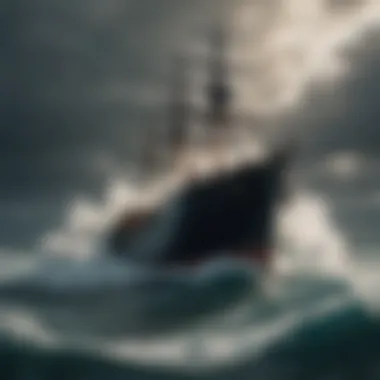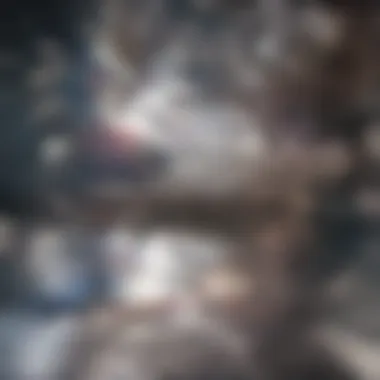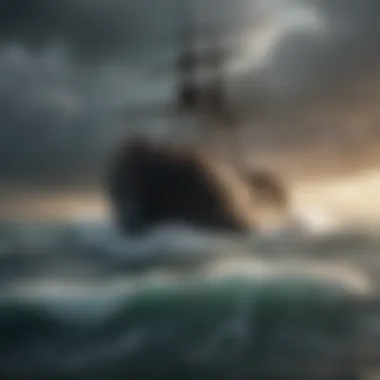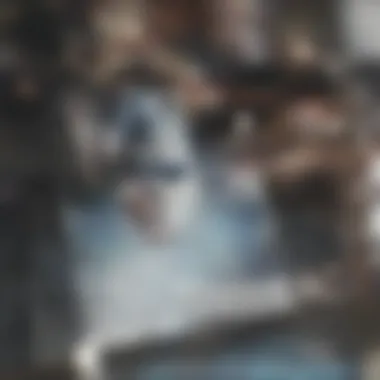Understanding Rogue Waves: Unraveling Ocean Mysteries


Intro
Rogue waves are a fascinating and often feared phenomenon in the world of oceanography. These waves, characterized by their unusually large heights and sudden appearance, challenge the conventional understanding of ocean wave patterns. They can arise unexpectedly and pose significant risks to maritime safety. Their unpredictable nature has led to numerous incidents involving ships and offshore structures, making them a critical area of study for scientists and safety professionals alike.
Key Research Findings
Overview of Recent Discoveries
Recent studies have shed light on the formation and behavior of rogue waves. High-profile research published in journals such as Nature and Journal of Physical Oceanography has started to outline possible mechanisms of formation such as non-linear wave interactions and underwater topography. Researchers have used advanced technologies like satellite observations and buoy data to identify the frequency and characteristics of rogue wave occurrences.
In 2020, scientists reported an unprecedented event where they captured data on a rogue wave exceeding 25 meters in height off the coast of Norway. This incident confirmed long-held suspicions regarding the heights rogue waves can achieve. Observation data show that these waves tend to cluster in certain regions known as "wave hotspots."
Significance of Findings in the Field
The implications of these findings are significant for maritime safety. Understanding the nature and patterns of rogue waves can lead to improved forecasting systems, allowing better preparation for maritime activities. As these waves are often responsible for damaging shipping vessels, investment in research is important.
A recent study highlighted that ships equipped with modern sensors were able to detect rogue waves earlier than traditional methods, potentially saving lives. Such technological advancements are critical for the shipping industry, offshore infrastructure, and even naval operations.
"The frequency and unpredictability of rogue waves necessitate a robust scientific approach to mitigate associated risks across maritime environments."
Breakdown of Complex Concepts
Simplification of Advanced Theories
To understand rogue waves, one must first grasp the basic principles of wave dynamics. Rogue waves often arise from the interplay of various wave conditions. When multiple smaller waves converge, their energies can combine, creating a much larger wave.
Additionally, the phenomenon of wave focusing can result in a rogue wave. This occurs when wave energy is concentrated in certain areas due to underwater features like ridges or cliffs, or even due to varying currents and wind patterns. These elements combine to create conditions ripe for the formation of a rogue wave.
Visual Aids and Infographics
To better explain these concepts, research often utilizes visual aids. Infographics can depict how rogue waves form and their geographical patterns. Mapping areas prone to these waves helps identify high-risk maritime routes. Such visuals aid in comprehension and retention of information, especially for students and professionals who might be new to this subject.
Prologue to Rogue Waves
Definition and Characteristics
A rogue wave is defined as an unusually large and unexpected ocean wave that is more than twice the height of surrounding waves. This definition emphasizes their extreme nature and rarity. Characteristically, rogue waves can emerge from various wave systems and possess features that challenge traditional wave theory. They are highly steep, can travel at high speeds, and may have a short wave period, making them particularly dangerous.
Their formation often contradicts the common sinusoidal wave patterns typically observed in ocean waves. Rogue waves are capable of damaging even the most robust vessels and structures. Research indicates that these waves originate from a combination of factors, including constructive interference of smaller waves, ocean currents, and winds acting together in complex ways. Therefore, a comprehensive understanding of their characteristics is essential for improving warning systems, enhancing naval architecture, and refining navigational procedures at sea.
Historical Context
The historical context of rogue waves draws on numerous accounts and incidents that have shaped maritime history. Many sailors and maritime professionals can recount experiences with these formidable waves. Notable incidents include the Draupner-platform wave recorded in 2004, which offered groundbreaking empirical evidence of rogue wave phenomena. Prior to this, rogue waves were often seen as maritime myths—stories of immense waves that could engulf ships instantly.
In 1966, sighting reports from ships and research vessels began to indicate that rogue waves were not merely anecdotal. Recognizing the reality of these waves has shifted academic and practical perspectives on ocean safety and weather forecasting. This historical evolution shows how complex and sometimes dangerous the ocean environment can be, thus underscoring the need for continuous research and development in this field.
Scientific Significance
The exploration of rogue waves carries significant importance within oceanography and related maritime fields. These waves challenge established theories of wave behavior and place emphasis on the need for deeper understanding of ocean dynamics. By studying rogue waves, scientists not only enhance the overall comprehension of wave mechanics but also improve safety measures for ships and maritime operations.
Impacts on Maritime Operations
Rogue waves pose a clear threat to maritime operations. Their sheer size can cause catastrophic damage to vessels, leading to injuries or loss of life. It is crucial to understand these waves and their unpredictability to formulate effective strategies for navigation and safety.
- Increased Risk: Shipping routes traverse areas where rogue waves can unexpectedly form. Cargo ships, tankers, and even passenger vessels can find themselves in peril, sometimes even capsizing because of such waves.
- Insurance and Economic Implications: Accidents caused by rogue waves lead to higher insurance premiums for maritime operators. These incidents can result in significant financial losses for companies involved in shipping and commerce.
- Weather Forecasting: Major advancements in maritime safety rely on precise weather forecasting. Identifying the potential formation of rogue waves allows ships to avoid dangerous areas before entering them, thereby minimizing risks associated with heavy seas.
Influence on Ocean Research


The study of rogue waves also influences ocean research on multiple fronts. By investigating these phenomena, researchers gain insights into the complex interactions that shape oceanic systems and wave patterns.
- Understanding Nonlinear Dynamics: Rogue waves highlight the nonlinear nature of wave interactions. Studying them assists scientists in refining existing models that describe wave behaviors, leading to better predictive methods for oceanic phenomena in general.
- Strengthening Ocean Modeling: Improved understanding of rogue wave formation contributes to enhanced ocean models, which are essential for both academic research and practical marine engineering.
- Cross-disciplinary Studies: The peculiar characteristics of rogue waves encourage collaborative efforts across various scientific disciplines. People from mathematics to climatology study these waves, which fosters a richer dialogue about ocean science.
"Rogue waves exemplify the ocean's mercurial nature, reminding us of our need for continued research and innovation in marine safety."
As marine safety and environmental understanding continue to be paramount, insights gleaned from rogue wave research will play a vital role in shaping future maritime protocols and technological advancements.
Physical Properties of Rogue Waves
The physical properties of rogue waves are fundamental to understanding their behavior and the risks they pose. These waves defy the established norms of ocean wave patterns, making their study essential. By examining their characteristics, we enhance maritime safety and improve our prediction capabilities.
Wave Height and Period
Rogue waves are notably distinguished by their immense heights. These waves can reach heights exceeding 25 meters, far exceeding normal sea conditions. The phenomenon of wave height is directly linked to the wave period, which refers to the time interval between consecutive wave crests. For rogue waves, the ratio of height to period tends to be substantial—this height-to-length ratio can lead to severe consequences for vessels caught in their path.
The extraordinary height of these waves can be attributed to several factors, including wave interference, which occurs when multiple waves converge. The period of rogue waves is often shorter than that of regular ocean waves, leading to a rapid rise that can catch mariners unprepared. Understanding these dynamics is crucial for developing effective safety protocols in marine operations.
Energy Concentration
Rogue waves exhibit significant energy concentration, which is a critical aspect of their physical properties. This concentration is what makes them so powerful and potentially devastating. The energy of a rogue wave can be vastly greater than that of surrounding waves. This energy is primarily a result of the unique interactions occurring within ocean currents and wind patterns.
Rogue waves can form when energy from surrounding waves is channeled into a single large wave, leading to a rapid increase in its energy. This causes a steep wave profile that can be extremely hazardous to ships. The ability to understand and measure the energy concentration of rogue waves has direct implications for navigation and safety at sea, allowing for better prediction and response strategies.
"The power of rogue waves lies in their unexpected nature, often amplifying energy in a way that blindsides even the most experienced mariners."
Both wave height and energy concentration are key elements in the ongoing research surrounding rogue waves. By studying these properties, scientists can uncover patterns that inform safer maritime practices and enhance our overall understanding of oceanographic phenomena.
Mechanisms of Formation
Understanding the mechanisms of formation of rogue waves is crucial in comprehending how these extraordinary phenomena manifest. Rogue waves challenge conventional wave theories and provide insights into ocean dynamics. Recognizing the various methods through which these waves arise is essential for enhancing maritime safety, improving engineering designs of vessels, and creating effective forecasting models.
Nonlinear Wave Interactions
Nonlinear wave interactions are a primary mechanism behind the formation of rogue waves. In simple terms, this refers to the way waves interact with each other. When multiple smaller waves converge or interact, they can combine their energy, resulting in a wave that significantly exceeds the average wave height. This process is called wave focusing.
Such interactions are influenced by various factors such as wave speed, direction, and height. The math involved, primarily from nonlinear Schroedinger equations, explains how energy can be transferred and concentrated in this manner.
- Key Points of Nonlinear Wave Interactions:
- The cumulative effects of smaller waves can lead to sudden formation of large waves.
- These waves can become significantly nonlinear under certain conditions, enhancing rogue wave potential.
- Compared to linear waves, nonlinear conditions contribute to unpredictable outcomes that are essential for understanding wave behaviors.
Oceanic Currents and Wind Effects
Oceanic currents and wind effects play a significant role in rogue wave formation. The interaction between surface winds and ocean currents can contribute to the exacerbation of wave heights. When wind moves in the same direction as the current, it can amplify wave energy. Conversely, if the wind is against the current, unusually large waves can form due to energy being trapped or focused in a localized area.
- Factors Involved in Oceanic Currents and Wind Effects:
- The speed of currents can influence local wave patterns and their heights.
- Wind speed and direction also crucially affect how waves build and propagate.
- These interactions highlight the importance of environmental factors in understanding wave dynamics.
Focusing Mechanisms
Focusing mechanisms involve a variety of physical processes that contribute to the rogue wave development. One critical aspect of focusing mechanisms is the presence of varying water depths, which affect wave speed and, thus, can enhance wave heights. In deep waters, waves propagate faster than in shallower waters, creating a situation where waves can bunch together when transitioning from deep to shallow areas.
These focusing effects can be observed in coastal zones and areas with complex seabed topography. Thus, understanding these mechanisms allows for predicting where rogue waves are likely to occur.
- Important Aspects of Focusing Mechanisms:


- Variability in water depth plays a crucial role in wave behavior.
- The convergence of multiple wave systems can lead to sudden wave enhancement.
- Recognizing geographic factors is essential for maritime operability and safety.
The combination of nonlinear interactions, oceanic currents, and focusing mechanisms illustrates the complexity behind the emergence of rogue waves, underlining the need for in-depth research and investigation.
Case Studies and Anecdotes
The study of rogue waves is significantly enriched by case studies and anecdotal evidence. These elements provide concrete illustrations of how rogue waves manifest in real-world scenarios. Through examining individual incidents, we gain insights not only into the physical properties of these waves but also their impact on human safety and maritime operations. Understanding these occurrences allows researchers to draw connections between theoretical models and actual events, validating or challenging existing scientific knowledge.
Noteworthy Incidents
Various documented incidents highlight the unpredictable and sometimes destructive nature of rogue waves. One of the most notable cases occurred in January 2004, when the cruise ship MS Maxim Gorkiy encountered a rogue wave while sailing in the Mediterranean Sea. The wave measured 26 meters, leading to significant damage onboard and leaving passengers shaken. This event underscored the unpredictability of such waves and raised questions about the capabilities of prevailing forecasting systems.
Another critical incident took place in 2007 with the Norwegian Pearl, which was struck by a rogue wave estimated at 30 feet. Witness reports detailed the suddenness of the wave's emergence, emphasizing how quickly these phenomena can alter the conditions at sea. These incidents illustrate the challenges faced by vessels of varying sizes and types when navigating potentially treacherous waters.
In addition to larger vessels, smaller crafts have also faced rogue waves. The case of a fishing boat near the coast of California that was capsized by a sudden wave provides insight into how small vessels can be equally vulnerable. The fishermen involved reported the wave seemed to rise from nowhere, highlighting the erratic nature of these ocean phenomena. Such accounts are vital in improving safety protocols and engineering designs for marine vehicles.
Survivor Accounts
Firsthand experiences from individuals who have survived rogue waves serve to further illuminate their dangers. Survivors from the MS Maxim Gorkiy incident recounted their feelings of helplessness as the immense wave struck, causing chaos aboard. Passengers reported immobilization of the crew, leaving them to navigate the aftermath as best as they could. Such narratives reveal the emotional and psychological effects of encountering a rogue wave, beyond the immediate physical dangers.
Another survivor from a sailing trip recounted an encounter with a rogue wave in the Atlantic Ocean. The suddenness of the wave and the lack of time to react led to a gripping sense of panic among the crew. This perspective adds depth to our understanding of how rogue waves can not only result in physical dangers but also deeply affect human psyche.
These accounts, when combined with scientific analysis, present a comprehensive picture of rogue waves. They illustrate the urgent need for enhanced safety measures and effective forecasting strategies to mitigate the risks associated with these unpredictable oceanic giants. Learning from these case studies and survivor stories offers opportunities for ongoing research and refinement of maritime safety practices.
Measurement and Forecasting
Understanding and predicting rogue waves require specific measurement and forecasting techniques. This aspect is critical because accurate forecasts can save lives and protect maritime operations. Rogue waves are not just large; they can strike without warning, making their observation and prediction essential in the maritime context.
Effective measurement techniques involve state-of-the-art technologies that can capture the height, wavelength, and speed of these waves. Accurate data collection is vital for scientists to analyze and understand rogue waves. Forecasting methods help predict the occurrence and magnitude of these waves. Some existing methods rely heavily on historical data, but advancements in technology offer new avenues for more reliable predictions.
"Accurate measurements of ocean waves can provide crucial information about the risks associated with maritime travel."
Current Techniques and Technologies
Modern technology plays a significant role in the measurement of rogue waves. One of the most notable techniques involves the use of satellite altimetry, which can assess the height of ocean waves from space. Instruments like Jason-3 provide continuous data about wave heights, which can indicate the presence of rogue waves. Other techniques include buoys and wave radar systems, both of which enable real-time data collection.
Additionally, numerical modeling is another important tool. It uses complex mathematical algorithms to simulate ocean dynamics. By integrating data from various sources, researchers can create predictive models that anticipate rogue wave formation.
Key Tools in Measurement:
- Satellite Instruments: Such as Jason-3.
- Wave Buoys: For real-time monitoring.
- Radar Systems: To track wave movement.
- Numerical Models: For predictive analysis.
Challenges in Forecasting
Forecasting rogue waves presents numerous challenges. Firstly, the unpredictability of these waves makes them complex to anticipate. The sporadic nature does not lend itself easily to regular forecasting methods.
Moreover, existing data may not always accurately represent potential rogue wave conditions. Historical records of wave patterns may lack the frequency needed to form robust predictive models. This gap increases the difficulty of anticipating rogue waves, especially in real-time scenarios.
Some of the specific challenges faced include:
- Sparse Data Availability: Historical datasets may not cover all areas.
- Rapid Changes in Ocean Conditions: Environmental factors can shift quickly.
- Complex Interactions: Between multiple oceanic phenomena complicate predictions.
To address these challenges, researchers emphasize ongoing development in both technology and theoretical approaches. The field of oceanography is constantly evolving, and as new technologies emerge, so do the opportunities to enhance measurement and forecasting related to rogue waves.
Impacts on Marine Vessels
Rogue waves pose significant risks to marine vessels throughout the world’s oceans. When these waves appear, they can generate unpredictable and powerful forces that challenge even well-designed ships. Understanding these impacts is critical for the safety of maritime operations and the integrity of vessel design.


Design and Engineering Challenges
The design of marine vessels must consider the potential for rogue waves. Traditional marine architecture often relies on average wave conditions for safety, leading to significant vulnerabilities when a rogue wave strikes. The following factors contribute to challenges in design and engineering:
- Wave Resistance: Ships must be engineered to withstand sudden forces. Rogue waves can be exponentially larger than surrounding waves, meaning that standard hull designs may not suffice. Engineers need to integrate materials and structural designs that can endure extreme pressure.
- Ballast Systems: The weight distribution of a vessel can be crucial. Engineers sometimes use advanced ballast systems that adjust automatically. Yet, such systems may not fully respond to the unexpected shift caused by a rogue wave.
- Stability and Control: A rogue wave can affect stability. Ships must incorporate advanced stabilization technology to counterbalance sudden tilting and provide controlled responses. This leads to increased complexity in the design phase.
Many manufacturers are now exploring innovative approaches that prioritize strength and adaptability to extreme conditions. Research on hydrodynamic modeling plays a crucial role in predicting how designs will hold up against these unpredictable forces.
Safety Measures and Protocols
Given the potential for catastrophic outcomes due to rogue waves, implementing robust safety measures is essential in maritime practices. Some of the key measures include:
- Crew Training: Regular training sessions focusing on rogue wave scenarios can prepare crews for emergencies. Knowledge of response protocols enhances safety in distress situations.
- Technology-Based Monitoring: Instruments like the Automatic Identification System (AIS) help communicate vessel position and surrounding conditions. Integrating advanced forecasting tools can further enhance situational awareness, allowing crews to take preventative action.
- Emergency Procedures: Clearly defined protocols for when a rogue wave is detected can guide decision-making. This includes informing crew members of emergency procedures and potential evacuation methods.
A comprehensive understanding of rogue waves and implemented safety measures can save lives and protect vessels.
- Safety Equipment: Investing in safety equipment such as life rafts and personal flotation devices can ensure preparation for worst-case scenarios. Additionally, some vessels are now designed with reinforced sections to protect critical areas during extreme events.
In summary, the impacts of rogue waves on marine vessels highlight the need for advanced design and rigorous safety protocols. Continuous advancements in design technology and crew preparedness are vital for mitigating the risks associated with this fascinating ocean phenomenon.
Future Research Directions
The study of rogue waves continues to evolve, reflecting the need for deeper understanding and improved safety measures. Future research directions are critical for comprehensively grasping these complex phenomena. This exploration can enhance forecasting techniques, deepen our knowledge of wave mechanics, and improve maritime safety protocols.
New Theories and Models
New theories and models are essential for capturing the multifaceted nature of rogue waves. Current scientific paradigms need expansion to fully understand how these waves form and behave. Researchers are exploring various approaches, including:
- Wave Interaction Models: These focus on the nonlinear interactions between smaller waves that can lead to the sudden emergence of larger waves.
- Hydrodynamic Simulations: Advanced simulations help scientists visualize rogue wave behavior under different oceanic conditions.
- Statistical Analysis: This approach examines historical data to identify patterns or triggers associated with rogue wave incidents.
Emphasizing collaboration across disciplines will likely yield new insights. The interplay between meteorology, oceanography, and engineering could facilitate the development of robust predictive models.
Technological Advancements
Technological advancements significantly impact the study and management of rogue waves. Innovations in instrumentation and data analysis are opening new avenues for research. Notable advancements include:
- Improved Wave Sensors: Modern sensors offer more accurate and real-time data collection. This information aids researchers in understanding wave dynamics more efficiently.
- Remote Sensing Technologies: Satellite technology helps monitor ocean conditions on a broader scale, providing critical data for forecasting.
- Machine Learning Algorithms: By leveraging large datasets, machine learning can assist in identifying trends and patterns that traditional methods may overlook.
Adopting these technologies can lead to more effective safety protocols. With precise data, maritime operations can adapt their routes or preparedness based on predicted rogue wave activity.
"The future of rogue wave research relies on innovative theories and state-of-the-art technology that bridge gaps in our current understanding."
Finale
First, it consolidates the current knowledge surrounding these powerful natural phenomena, elucidating their unpredictable nature and the challenges they present. Knowing their characteristics can help mariners enhance safety protocols and better mitigate risks while at sea.
Second, ongoing research is vital. It informs best practices in maritime operations and potentially shapes policies to improve safety in various oceanic environments. Research also fuels technological advancements in navigational systems and models designed to predict rogue waves accurately.
Lastly, rogue waves remain a subject of scientific curiosity. They challenge prevailing theories of wave behavior, urging experts in oceanography to reevaluate existing models.
"The study of rogue waves exemplifies how nature’s complexity demands a continuous quest for understanding."
In summary, the findings presented in this article emphasize the intrinsic significance of rogue waves in both practical and theoretical contexts. By ongoing exploration and discussions, the maritime community and researchers can push toward safer waters and enriched scientific comprehension.
Summary of Key Points
- Rogue waves are large and unpredictable, redefining what is considered normal in wave behavior.
- Historical context provides insight into notable incidents and survival stories, underlining the weight of their impacts.
- Various mechanisms contribute to the formation of rogue waves, with nonlinear interactions being one of the most significant.
- Advance measurement and forecasting techniques are crucial but face ongoing challenges.
- Future research aims to refine current understanding and explore new theories that could reshape oceanographic studies.
Significance of Ongoing Research
Ongoing research into rogue waves is indispensable. At its core, it encourages continual learning and adaptation in the field of oceanography. As new technologies emerge, the capability to analyze and forecast these waves improves. This can lead to better preparedness for maritime operations.
In essence, as researchers uncover new dimensions of rogue waves, they not only enhance maritime safety but also expand the horizons of ocean science itself.















